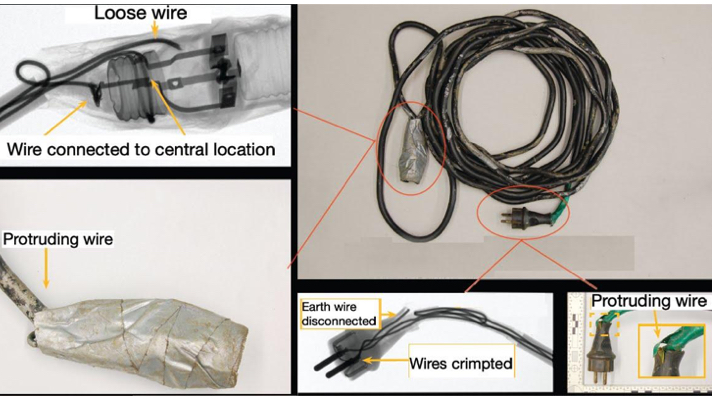(Mars 201915) Electrical chords should never be improvised, repaired or otherwise jury-rigged. In this incident, a crew member lost his life after coming into contact with a live wire.
As edited from Dutch Safety Board official report published August 2017
The crew were carrying out maintenance work on the vessel while at anchor. One of the jobs was to paint the bilge water retention tank in the engine room. The tank was opened, ventilated and the atmosphere tested, in line with procedure. The bosun worked in the tank while the apprentice assisted outside the tank, mixing paint and passing down material. The bosun used torches and rechargeable lamps to provide light within the tank.
Work was stopped for coffee. When they returned to the tank, the bosun was carrying cable that had a lamp fixed to one end and a plug on the other. Tape was wrapped around both the lamp’s fitting end and the plug end. The bosun inserted the plug in a wall socket near the tank and took the lamp into the tank.
At one point the apprentice wanted to hand the bosun some more mixed paint, but the bosun did not reply to his questions. When the apprentice looked into the tank, illuminating it with a torch, he saw the bosun was lying unconscious at the bottom of the tank. The alarm was raised and a rescue was initiated with the help of breathing apparatus.
Resuscitation was started and continued while the victim was evacuated ashore, but he was pronounced dead at the hospital.
The report found that the victim probably died as a result of electrocution from direct contact with the live wire as a result of the opening in the cable covering, although other causes could not be ruled out entirely.
Lessons Learned
- Inadequate supervision, as in this case, can have disastrous consequences.
- Under no circumstances should electrical cords be improvised, repaired or otherwise jury-rigged. Only undamaged, intact cords that are manufactured for such use should be employed. Better yet, use battery-powered lighting in confined spaces.
- Never underestimate the deadly power of ship’s main electrical power.
Mars Reports
This is one of the March Mars Reports that are part of Report Number 317. A selection of this Report has also been published in SWZ|Maritime’s April issue.
Acknowledgement
Through the kind intermediary of The Nautical Institute we gratefully acknowledge sponsorship provided by:
American Bureau of Shipping, AR Brink & Associates, Britannia P&I Club, Cargill, Class NK, DNV, Gard, IHS Fairplay Safety at Sea International, International Institute of Marine Surveying, Lairdside Maritime Centre, London Offshore Consultants, MOL Tankship Management (Europe) Ltd, Noble Denton, North of England P&I Club, Sail Training International, Shipowners Club, The Marine Society and Sea Cadets, The Swedish Club, UK Hydrographic Office, West of England P&I Club
Submit a Mars Report
More reports are needed to keep the scheme interesting and informative. All reports are read only by the Mars coordinator and are treated in the strictest confidence. To submit a report, please use the Mars report form and send it to mars@nautinst.org.








